
by A Touch of Dutch Landscaping | Jul 29, 2020 | Hardscaping, Landscape Design, Retaining Walls, Softscaping, Trees, Walkways, Water Features
Enjoy living in your backyard, not just swimming in your pool
When adding a pool to your backyard, the actual installation of the pool is only half the job. The other half is comprised of what goes around the pool to give your backyard oasis polish and make the area more livable.
Enter landscaping. Both softscaping (trees, shrubs, and flowerbeds) and hardscaping (decking, fences, patios, walkways, and retaining walls) can turn your new pool space into a backyard oasis. The key is adding the right elements that will fit your style, lifestyle, and budget.
To streamline your planning process, consider your vision, then how you want the space around your pool to function, and finally of course, your budget.
Vision
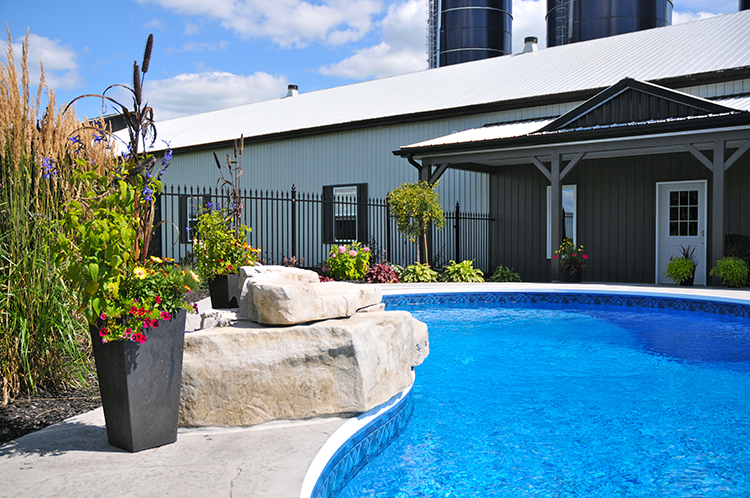 This is your invitation to have a big “blue sky” session. Include others who will also be using the finished space and note all wants and needs. Pinterest is a great tool for curating your vision in a private vision board that you can share with your landscaping professional.
This is your invitation to have a big “blue sky” session. Include others who will also be using the finished space and note all wants and needs. Pinterest is a great tool for curating your vision in a private vision board that you can share with your landscaping professional.
This is not the time to stifle creativity with practical matters. Browse through images of other backyard pool areas and gather inspiration. If something looks too big, too complex, or too fancy, keep in mind that elements that you like can be scaled down, simplified, or otherwise altered to meet your needs and budget during later planning stages.
Right now, just allow yourself to think big and think of possibilities.
Function
 This step incorporates more practicality into your plan. Take some time to think about how you will be using your finished backyard. Talk to other pool owners about the things they love most about their yard and perhaps what they would have done differently if they could do it again.
This step incorporates more practicality into your plan. Take some time to think about how you will be using your finished backyard. Talk to other pool owners about the things they love most about their yard and perhaps what they would have done differently if they could do it again.
Consider maintenance required for trees, shrubs, and gardens. Do you need shade? Do you want more colour? Do you want fast-growing plants and trees or would you prefer softscaping whose shape and size is easy to maintain?
Do you want a large patio for lounging with family and friends? Do you want additional privacy? What about lighting for nighttime use? And you’ll likely need storage for pool and patio furniture and accessories. When we meet with clients, we address all of these things, but many people like to conduct their own due diligence beforehand.
Budget
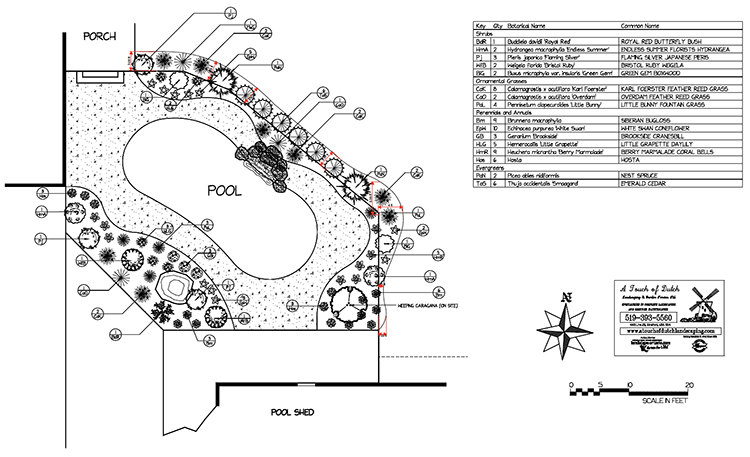 From modest to unlimited, we work with all kinds of budgets. And we’ll be happy to work within yours while showing you how to maximize the return on your investment without compromising your entire vision.
From modest to unlimited, we work with all kinds of budgets. And we’ll be happy to work within yours while showing you how to maximize the return on your investment without compromising your entire vision.
Like most other landscaping projects, converting your backyard pool installation into a full backyard oasis can be accomplished in phases. So, if your current budget doesn’t allow for everything on your wish list, consider breaking the project into steps, adding your wish list elements over two or more years. We can help you establish priorities based on budget and short- versus long-term needs, and then create a plan accordingly.
A backyard pool project is exciting. However, if you want to spend your summers in your backyard, but not always in your pool, how you landscape and furnish the space around the pool is as important as the pool itself.
We love working with clients to make their backyard dreams a reality and are happy to work with you at your pace to bring your dreams to life. Contact us for assistance at any stage of the process.

by A Touch of Dutch Landscaping | Jun 24, 2020 | Fencing, Flowers, Gardening, Hardscaping, Lawn care, Maintenance, Ponds, Retaining Walls, Shrubs, Softscaping, Trees, Walkways, Water Features
Enhance the appearance and enjoyment of your home on any budget
First impressions are lasting impressions. And this is as true of your home’s appearance as it is your personal appearance. Little updates can go a long way. Of course, extensive updates can as well. Regardless of your budget, we’ve compiled some landscaping tips below that will help you put your home’s best foot forward.
Any Budget
Lawn Care
 If your home has a grass-dominant greenspace in front, keeping your lawn neat and tidy is a no brainer for improving and maintaining curb appeal. Keep grass cut to a consistent length, but not too short as doing so can cause undue stress and increased exposure to weeds and pests. Edging your lawn along walkways, gardens, and your driveway provide a nice, polished appearance as well.
If your home has a grass-dominant greenspace in front, keeping your lawn neat and tidy is a no brainer for improving and maintaining curb appeal. Keep grass cut to a consistent length, but not too short as doing so can cause undue stress and increased exposure to weeds and pests. Edging your lawn along walkways, gardens, and your driveway provide a nice, polished appearance as well.
Garden Maintenance
Eliminate dead foliage as seasons change and cut back or split any overgrown perennials. Pull weeds and apply a thick layer of mulch, which will instantly give your flowerbeds a uniform appearance. Mulch has the added benefit of helping to maintain moisture and keep weed growth down.
Pruning & Trimming
It’s hard for people to get a first impression of your home if they can’t see it. If you have large trees, trim back dead limbs and those that block the view and/or sidewalks. Shrubs against your home and along walkways should be pruned and shaped. And be sure to train any wayward vines on a trellis, pergola, or fence.
Hardscape Repair
We can’t overlook your yard’s stairs, walkways and driveways. If your stone or concrete is in a state of disrepair, it can take away from your home’s otherwise neat appearance. Eliminate weeds popping up in cracks and repair or replace broken stones or pavers. Ensure all hard elements are level and secured in place to ensure the safety of your visitors.
Moderate Budget
With a moderate budget, you can add some architectural interest to your front yard and entrance that will make it look more inviting. Here are a few ways to add warmth to your home’s façade:
Softscaping
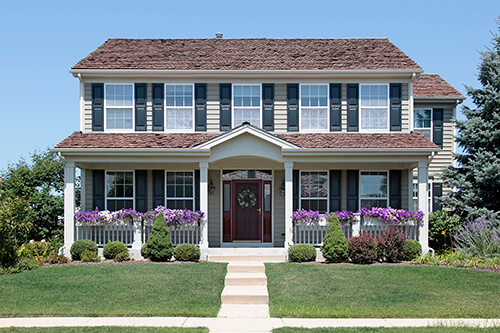 Fill in flat, exposed areas of your home’s exterior with shrubs, ornamental grasses, and small trees. This will add depth, balance, and visual interest to areas that were previously a blank canvas. Remember not to obstruct windows.
Fill in flat, exposed areas of your home’s exterior with shrubs, ornamental grasses, and small trees. This will add depth, balance, and visual interest to areas that were previously a blank canvas. Remember not to obstruct windows.
Window boxes
Adding boxes of annuals below windows allows you to add splashes of colour in the warmer months and perhaps some seasonal décor for the holidays. Ensure that box shape and size is balanced with window size and coordinated with the rest of your home’s exterior finishes.
Sitting area
Create or better define an area where you can sit and watch the world go by. A small stone patio or porch not only increases curb appeal but also creates additional outdoor lounging space. Be sure to add appropriately-sized greenery to add visual interest and a bit of privacy.
Small water feature
The appearance and sound of a bubbling rock or small fountain creates an attractive focal point for passersby and enhances your own enjoyment of a front patio or porch. Birds are also more likely to visit feeders when there is a nearby water source.
Upgraded concrete steps or walkway
Consider upgrading your standard concrete sidewalk and/or stairs with natural stone pavers. You can create a traditional or modern look to match the style of your home, and this upgrade can add significant visual impact to your front entrance.
Shade tree
While planting a tree won’t provide instant shade, over time a properly selected and placed tree will provide visual interest as it matures. Some varieties grow faster than others, so if you’re looking for quick results, consider a Birch, Ivory Silk Lilac, Crab Apple, or a smaller Maple variety like the Tartarian Maple.
Larger Budget
If you have a more significant budget for upgrading your front yard and entrance, here are some sure-fire ways to enhance curb appeal and enjoyment while adding value to your home.
Upgraded driveway
 Consider replacing your asphalt driveway with a professionally-installed stamped concrete or natural paver driveway. This area of your front yard is highly visible from the street and sidewalk, so making it visually interesting not only adds curb appeal but also distinguishes your home from others in your neighbourhood.
Consider replacing your asphalt driveway with a professionally-installed stamped concrete or natural paver driveway. This area of your front yard is highly visible from the street and sidewalk, so making it visually interesting not only adds curb appeal but also distinguishes your home from others in your neighbourhood.
Privacy or windscreen
Adding a row of small trees, shrubs, or natural grasses can add privacy, cut down on wind exposure, and better define your property. As an alternative, you might consider mixing well-placed fence panels with shrubbery for a balanced and visually-compelling appearance.
Pond or water feature
Many find the sights and sounds of a pond or waterfall both calming and visually appealing. Adding a water feature that is proportionate to the size of your house and yard increases the value and enjoyment of your home. Adding lighting allows you to enjoy your pond or waterfall even after the sun has gone down.
Multi-tiered gardens
If your house is tall and you’re your front yard is sloped, you might consider adding tiered flowerbeds defined and contained by natural stone retaining walls. For colour and interest throughout the year, fill your beds with a mix of shrubs, flowering trees, perennials, and annuals in a balanced mix of shapes and sizes.
Whether you’re getting your house ready to put on the market or just keeping up with the Jones down the street, there are big and small things you can do to improve your home’s appearance and value. Of course, if you’re not up to the task, we are here to help. Just contact us to get started.

by A Touch of Dutch Landscaping | Mar 29, 2020 | Flowers, Gardening, Native Plants, Shrubs, Softscaping, Trees
Creating a healthy local ecosystem in our own backyards
There have been myriad reports over the past few months from backyard birders about the decrease in visitors to their feeders. If you’ve noticed this too, you’ll be pleased to know there are things we can each do to radically reverse the decline of small wildlife in our yards.
 It’s all well and good to provide seed and suet for birds, but the solution to population decline requires us to look a little closer. Instead of thinking short-term, say season by season, let’s look at it from a yearly perspective, or even longer.
It’s all well and good to provide seed and suet for birds, but the solution to population decline requires us to look a little closer. Instead of thinking short-term, say season by season, let’s look at it from a yearly perspective, or even longer.
What we choose to plant directly affects the quantity and activity of small and large living organisms in our yards. If our only priority is a yard that looks pretty, we may be missing opportunities to positively impact the local ecosystem.
We should also consider biodiversity – choosing a variety of species that co-exist nicely. If we also opt for plants and trees that require minimal resources for survival, then we can move toward a landscape that not only looks good, but is low-maintenance and welcomes beneficial interdependent activity above and below ground.
 Wildlife Ecologist Doug Tallamy, author of “Nature’s Best Hope: A new approach to conservation that starts in your yard” offers strong arguments and simple tips for being a backyard conservationist. Here are a handful of his suggestions:
Wildlife Ecologist Doug Tallamy, author of “Nature’s Best Hope: A new approach to conservation that starts in your yard” offers strong arguments and simple tips for being a backyard conservationist. Here are a handful of his suggestions:
- Reduce the amount of lawn in your yard to that which you require for walking and playing. Fill this area instead with more productive “host” plants.
- Over thousands of years, native fauna has developed defences and tolerances (and thus, preferences) for consuming native flora (plants with which it has co-evolved), so naturally if we replace these native food sources with non-native alternatives, local wildlife will either have to go elsewhere for food or perish.
- If not kept in check, unproductive, foreign cultivars can become invasive species, choking out native plant life beyond our back yards.
- We currently have 3 billion fewer birds than we did 50 years ago. Globalization and hybridization have replaced native garden options with more “exotic” options that might be fashionable, but don’t contribute to the local ecosystem.
- A great deal of the animals in any ecosystem don’t eat plants, but eat something that eats something that eats plants, so ensuring the right plants are available as a food source for caterpillars and insects is a very big deal to our entire ecosystem.
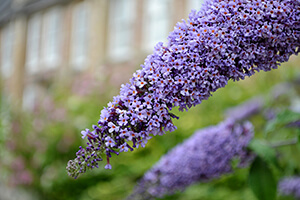 The good news is this isn’t an all-or-nothing proposition. You don’t have to swap out all of the plant life in your garden and risk disrupting your current modern or tropical motif, for example. Plants that are native to Ontario come in a wide range of shapes, sizes, and colours, so you’re sure to find a few cultivars that appeal to you.
The good news is this isn’t an all-or-nothing proposition. You don’t have to swap out all of the plant life in your garden and risk disrupting your current modern or tropical motif, for example. Plants that are native to Ontario come in a wide range of shapes, sizes, and colours, so you’re sure to find a few cultivars that appeal to you.
And adding just a few native plants and trees will produce favourable results. Visit our June 2019 post on Choosing Native Ontario Plants for Your Garden or head over to our Native Ontario Plants Pinterest Board for some inspiration.
As always, if you need assistance choosing the right native plants and trees for your yard, or you just want to get started on a landscaping project, contact us.

by A Touch of Dutch Landscaping | Sep 28, 2019 | Flowers, Foliage, Gardening, Landscape Design, Shrubs, Trees
Most of us would be hard pressed to find a person who doesn’t love the colours of fall. Yes, winter will inevitably follow fall, and probably earlier than we’d like. But, in the meantime, we’ve still got warm daytime temperatures, cool evenings, and so much colour to enjoy.
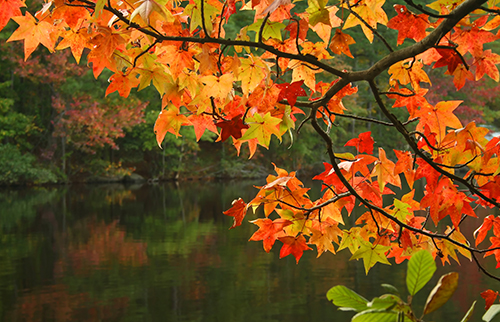 While the trees, plants, and shrubs throughout Southwestern Ontario offer up a lot of colour, many homeowners want colour in their own yards, as well. There are some quick fixes for this – displaying pumpkins, potted mums, and faux leaves and floral décor, for example. However, adding perennial colour to your fall garden takes a bit more forethought.
While the trees, plants, and shrubs throughout Southwestern Ontario offer up a lot of colour, many homeowners want colour in their own yards, as well. There are some quick fixes for this – displaying pumpkins, potted mums, and faux leaves and floral décor, for example. However, adding perennial colour to your fall garden takes a bit more forethought.
When planning gardens, home gardeners generally work in chronological order, considering what’s going to bloom or otherwise be at its peak in spring and then what will be at its best in summer. For this reason, autumn may tend to take a backseat where plant selection is concerned. To prolong the enjoyment of your gardens though, you may want to make room for a few fall favourites in your yard.
 Plant retailers and nurseries might be among your best resources for determining what’s at its colourful peak right now. They tend to sell what’s in season, when it’s in season. And the warm, sunny days, cool nights, and more regular precipitation of early fall can be the perfect time to plant, offering ideal conditions for new plants, trees, and shrubs to take root before the first frost.
Plant retailers and nurseries might be among your best resources for determining what’s at its colourful peak right now. They tend to sell what’s in season, when it’s in season. And the warm, sunny days, cool nights, and more regular precipitation of early fall can be the perfect time to plant, offering ideal conditions for new plants, trees, and shrubs to take root before the first frost.
A few selections that fare well in our region in the fall include:
- Burning Bush (Euonymus alatas) – normally green deciduous foliage turns vibrant red
- Wayfaring Tree (Vibunum Lantana)
- Sugar Maple (Acer Saccharum) – foliage turns orange and red
- Mountain Ash (Sorbus) – foliage turns orange, red, and yellow
- Witch Hazel (Hamamelis) – foliage turns bright yellow
- Butterfly Bush (Buddleia) – flowers in fall, showing purple, blue, pink, and white
- Chrysanthemum (C. x morifolium) – fall flowers in yellow, orange, purple, red, burgundy, white, and bronze
- Purple Coneflower (Echinacea Purpurea) – large purple flowers and prominent seed heads
- Coralbells (Heuchera) – flowers throughout the season, leaves can show purple/bronze
- Rosemallow (Hibiscus Moscheutos) – large, saucer-like blooms are pink, blue, or purple
- Sedum Autumn Joy (Sedum spectabile) – flower clusters are generally pink or light purple
- Goldenrod (Solidago spp.) – bright yellow, flower clusters
Keep in mind though, that your plants and trees need a bit of TLC in order to get established before the first frost. Otherwise your investment of time and money may be for naught. If you’re not getting ample rainfall, you should water new plants thoroughly and consistently to help roots get established before the ground freezes. And ensure you get everything into the ground before the snow flies, as plants will have a much better chance of surviving the winter there than in the thin, plastic pots in which they’re generally sold.
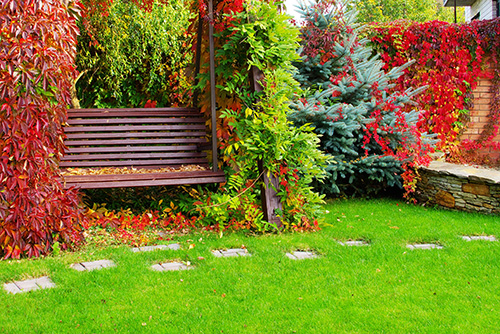 Once plants are in the ground, most of the initial growth is going to take place below the soil, which is good. So, don’t be disappointed if you see much going on above ground. Your patience will be rewarded with healthy, showy plants next year. To help things along and protect vulnerable young root systems, add a thick layer (4 inches) of mulch around plants. Mulch will add much needed insulation to keep heat in and cold out.
Once plants are in the ground, most of the initial growth is going to take place below the soil, which is good. So, don’t be disappointed if you see much going on above ground. Your patience will be rewarded with healthy, showy plants next year. To help things along and protect vulnerable young root systems, add a thick layer (4 inches) of mulch around plants. Mulch will add much needed insulation to keep heat in and cold out.
Although fall is a great time for planting, there are some exceptions. Evergreens need more time to adjust and build up stores of moisture. If not, they may dry out over the winter when the ground is hard and water supply is cut off. Also, some plants and shrubs sustain a bit of damage throughout the winter. A newly planted specimen may not be sufficiently established to handle the first winter, and may not make it through.
And finally, if you’re wanting to press your luck by planting something that is not ideally suited to your hardiness zone (Southwestern Ontario ranges anywhere from Zone 5 to 7), it will have a much better chance of surviving our winters if planted in spring and given a full growing season to acclimate.
Although many homeowners will start putting their gardens to bed for the year, plants are still growing and thriving in the early to mid-fall conditions. Take advantage of this time to change up your gardens, adding splashes of fall colour not just for this year, but for years to come.

by A Touch of Dutch Landscaping | Jun 4, 2019 | Flowers, Landscape Design, Native Plants, Shrubs, Trees
Native plants are those that have thrived in their original region for centuries. Just like native animals, they have evolved over the years to adapt to changes in their environment.
In the last half of the twentieth century, the ever-burgeoning global marketplace opened people’s eyes to foreign and exotic varieties. Increasingly, hybrids of non-native species were created to adapt these plants to different climates.
However, in the last 15 – 20 years native species are making a comeback for several reasons.
It’s not an all-or-nothing proposition
Native varieties can generally be planted with non-native plants, assuming their sun, water, and soil requirements are similar. And the wide range of native species available means you can always find one or more that suits your gardens’ style, whether traditional, contemporary, or somewhere in between.
Enjoy your garden without having to tend to it all the time
Native plants tend are generally well adapted to their environment. So as long as you’re planting them in their preferred surroundings in terms of exposure to sun, precipitation, and soil type they should require little if any maintenance, especially once established.
Invite beneficial wildlife into your yard
One of the major reasons that native gardening is regaining popularity is its ability to attract pollinators like birds, bees, and butterflies. Native vegetation offers nutritionally-appropriate food as well as shelter to some of your region’s wildlife.
They don’t call them hardiness zones for nothing
Because your region’s original plants have evolved in your climate, they have developed certain immunities that make them more resilient in the face of pests and disease.
They’re just as beautiful and varied as their imported counterparts
While many perceive some native plants and wildflowers to be weedy and undesirable, there’s an extensive range of plants, trees, and bushes that have showy, colourful flowers and foliage, bright berries, and subtle fragrance.
If you’re interested in adding more native content to your garden, the following are some of the more popular native species, divided into five categories.
Trees
 While our country is known for the maple leaf, there are actually more than 150 varieties of maple throughout the world and only a handful of them are indigenous to Canada. But we’ve got more than just maples trees in our backyard. The range of native coniferous and deciduous trees in our region is quite diverse, each with its own unique traits.
While our country is known for the maple leaf, there are actually more than 150 varieties of maple throughout the world and only a handful of them are indigenous to Canada. But we’ve got more than just maples trees in our backyard. The range of native coniferous and deciduous trees in our region is quite diverse, each with its own unique traits.
Among our native deciduous tree species are the Ironwood, Cottonwood, and Oak, while coniferous native trees include White Cedar, Red Pine, and both Black and White Spruce.
Shrubs
 Our region offers some beautiful native shrubs that will add colour and texture to any landscape. Foliage ranges from bright green and smokey-blue, to purple and brilliant red, depending on the season. Many shrubs have a flower phase as well, temporarily enhancing its natural beauty and fragrance.
Our region offers some beautiful native shrubs that will add colour and texture to any landscape. Foliage ranges from bright green and smokey-blue, to purple and brilliant red, depending on the season. Many shrubs have a flower phase as well, temporarily enhancing its natural beauty and fragrance.
Varieties include the Honeysuckle Bush, whose flowers attract hummingbirds, bees, and butterflies. The Serviceberry is a popular native choice, covered in small white flowers in the spring and changing to brilliantly-coloured foliage in the fall. Witch Hazel shows green foliage throughout the summer and, after leaves begin to drop in the fall, shows off unique, bright yellow flowers.
Perennials
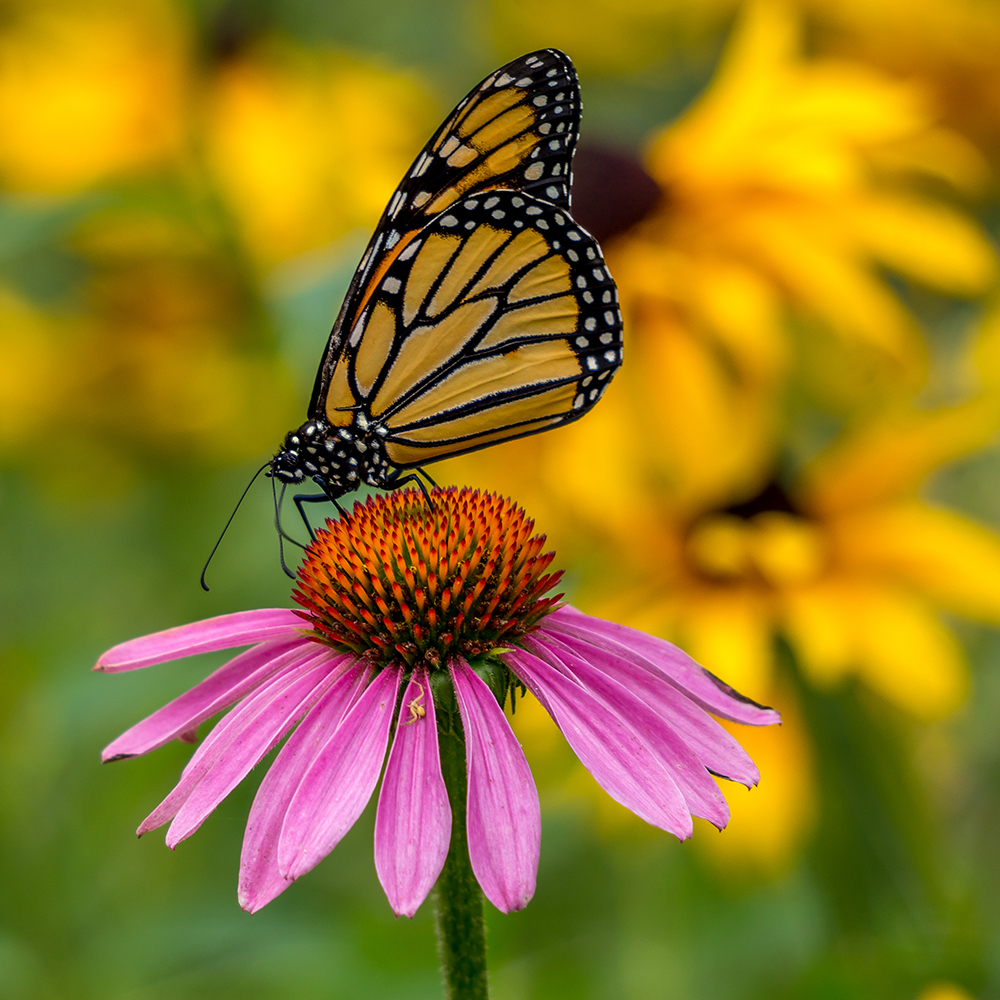 Ontario’s hardy perennials are not only resilient but showy as well. Some are low-lying ground cover while others grow tall, which means it’s easy to create a stunning perennial garden consisting solely of native plants.
Ontario’s hardy perennials are not only resilient but showy as well. Some are low-lying ground cover while others grow tall, which means it’s easy to create a stunning perennial garden consisting solely of native plants.
Choose from brightly coloured Echinacea and Black-Eyed Susan, or pretty purple-pink Border Phlox. The fragrant Bee Balm’s flowers attract pollinators in the summer while its seed heads are a food source for birds in the winter. The Blanket Flower (in the Aster family) has sunshiney red and yellow flower heads, and Columbine can add a modern look to your garden with its long-stemmed nodding flowers.
We’d be remiss if we didn’t mention Ontario’s floral emblem, the Trillium. The beauty of this groundcover is in the simplicity of the flower. And contrary to popular belief, it is not illegal to pick a Trillium, but it’s not advisable as plants are easily damaged and difficult to successfully transplant.
Edible Fruit
 There are so many options when it comes to choosing edible fruit-bearing plants and trees native to Ontario. Various hard fruit trees like apple and crabapple varieties thrive here because they’re native to the region. Elderberry and raspberry (black, flowering purple, wild red) bushes are also native to our region and yield delicious fruit than can be eaten out of hand or baked into a multitude of desserts. The fruit of the Sumac is interesting as the berries are used as a seasoning.
There are so many options when it comes to choosing edible fruit-bearing plants and trees native to Ontario. Various hard fruit trees like apple and crabapple varieties thrive here because they’re native to the region. Elderberry and raspberry (black, flowering purple, wild red) bushes are also native to our region and yield delicious fruit than can be eaten out of hand or baked into a multitude of desserts. The fruit of the Sumac is interesting as the berries are used as a seasoning.
Ferns & Grasses
 Suffice it to say that if you’re looking for native ferns and/or grasses in our region, your options are wide open. The Ostrich Fern is one of the most popular native ferns but it’s really just the tip of the iceberg. Regardless of which fern you choose, just ensure it’s planted in part to full shade with consistently moist soil. If you prefer grasses, there are myriad native varieties, both long and short. Many flower in the late summer/early fall and provide great visual interest in the winter as well.
Suffice it to say that if you’re looking for native ferns and/or grasses in our region, your options are wide open. The Ostrich Fern is one of the most popular native ferns but it’s really just the tip of the iceberg. Regardless of which fern you choose, just ensure it’s planted in part to full shade with consistently moist soil. If you prefer grasses, there are myriad native varieties, both long and short. Many flower in the late summer/early fall and provide great visual interest in the winter as well.
Gardening with native plants is not difficult. Not only are the plants, shrubs and trees easy to find at nurseries throughout the region, they’re even easier to incorporate into any landscape. If you’re interested in achieving a more beautiful native garden that attracts pollinators but you don’t want to do it yourself, contact A Touch of Dutch Landscaping & Garden Services.

 This is your invitation to have a big “blue sky” session. Include others who will also be using the finished space and note all wants and needs. Pinterest is a great tool for curating your vision in a private vision board that you can share with your landscaping professional.
This is your invitation to have a big “blue sky” session. Include others who will also be using the finished space and note all wants and needs. Pinterest is a great tool for curating your vision in a private vision board that you can share with your landscaping professional. This step incorporates more practicality into your plan. Take some time to think about how you will be using your finished backyard. Talk to other pool owners about the things they love most about their yard and perhaps what they would have done differently if they could do it again.
This step incorporates more practicality into your plan. Take some time to think about how you will be using your finished backyard. Talk to other pool owners about the things they love most about their yard and perhaps what they would have done differently if they could do it again. From modest to unlimited, we work with all kinds of budgets. And we’ll be happy to work within yours while showing you how to maximize the return on your investment without compromising your entire vision.
From modest to unlimited, we work with all kinds of budgets. And we’ll be happy to work within yours while showing you how to maximize the return on your investment without compromising your entire vision.

 If your home has a grass-dominant greenspace in front, keeping your lawn neat and tidy is a no brainer for improving and maintaining curb appeal. Keep grass cut to a consistent length, but not too short as doing so can cause undue stress and increased exposure to weeds and pests. Edging your lawn along walkways, gardens, and your driveway provide a nice, polished appearance as well.
If your home has a grass-dominant greenspace in front, keeping your lawn neat and tidy is a no brainer for improving and maintaining curb appeal. Keep grass cut to a consistent length, but not too short as doing so can cause undue stress and increased exposure to weeds and pests. Edging your lawn along walkways, gardens, and your driveway provide a nice, polished appearance as well. Fill in flat, exposed areas of your home’s exterior with shrubs, ornamental grasses, and small trees. This will add depth, balance, and visual interest to areas that were previously a blank canvas. Remember not to obstruct windows.
Fill in flat, exposed areas of your home’s exterior with shrubs, ornamental grasses, and small trees. This will add depth, balance, and visual interest to areas that were previously a blank canvas. Remember not to obstruct windows. Consider replacing your asphalt driveway with a professionally-installed stamped concrete or natural paver driveway. This area of your front yard is highly visible from the street and sidewalk, so making it visually interesting not only adds curb appeal but also distinguishes your home from others in your neighbourhood.
Consider replacing your asphalt driveway with a professionally-installed stamped concrete or natural paver driveway. This area of your front yard is highly visible from the street and sidewalk, so making it visually interesting not only adds curb appeal but also distinguishes your home from others in your neighbourhood.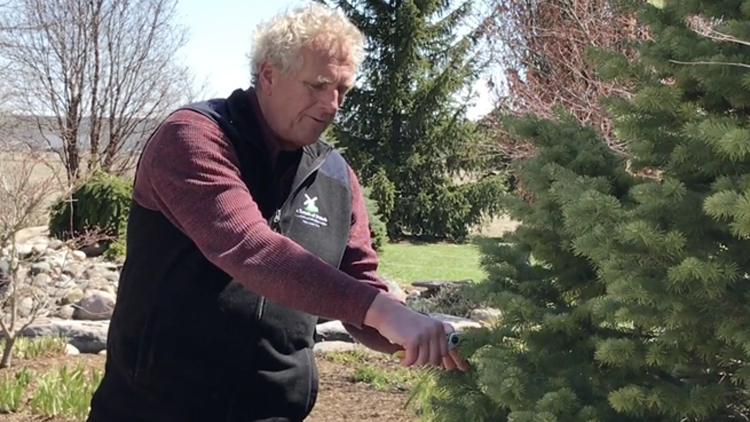

 It’s all well and good to provide seed and suet for birds, but the solution to population decline requires us to look a little closer. Instead of thinking short-term, say season by season, let’s look at it from a yearly perspective, or even longer.
It’s all well and good to provide seed and suet for birds, but the solution to population decline requires us to look a little closer. Instead of thinking short-term, say season by season, let’s look at it from a yearly perspective, or even longer. Wildlife Ecologist Doug Tallamy, author of “
Wildlife Ecologist Doug Tallamy, author of “ The good news is this isn’t an all-or-nothing proposition. You don’t have to swap out all of the plant life in your garden and risk disrupting your current modern or tropical motif, for example.
The good news is this isn’t an all-or-nothing proposition. You don’t have to swap out all of the plant life in your garden and risk disrupting your current modern or tropical motif, for example. 
 While the trees, plants, and shrubs throughout Southwestern Ontario offer up a lot of colour, many homeowners want colour in their own yards, as well. There are some quick fixes for this – displaying pumpkins, potted mums, and faux leaves and floral décor, for example. However, adding perennial colour to your fall garden takes a bit more forethought.
While the trees, plants, and shrubs throughout Southwestern Ontario offer up a lot of colour, many homeowners want colour in their own yards, as well. There are some quick fixes for this – displaying pumpkins, potted mums, and faux leaves and floral décor, for example. However, adding perennial colour to your fall garden takes a bit more forethought. Plant retailers and nurseries might be among your best resources for determining what’s at its colourful peak right now. They tend to sell what’s in season, when it’s in season. And the warm, sunny days, cool nights, and more regular precipitation of early fall can be the perfect time to plant, offering ideal conditions for new plants, trees, and shrubs to take root before the first frost.
Plant retailers and nurseries might be among your best resources for determining what’s at its colourful peak right now. They tend to sell what’s in season, when it’s in season. And the warm, sunny days, cool nights, and more regular precipitation of early fall can be the perfect time to plant, offering ideal conditions for new plants, trees, and shrubs to take root before the first frost. Once plants are in the ground, most of the initial growth is going to take place below the soil, which is good. So, don’t be disappointed if you see much going on above ground. Your patience will be rewarded with healthy, showy plants next year. To help things along and protect vulnerable young root systems, add a thick layer (4 inches) of mulch around plants. Mulch will add much needed insulation to keep heat in and cold out.
Once plants are in the ground, most of the initial growth is going to take place below the soil, which is good. So, don’t be disappointed if you see much going on above ground. Your patience will be rewarded with healthy, showy plants next year. To help things along and protect vulnerable young root systems, add a thick layer (4 inches) of mulch around plants. Mulch will add much needed insulation to keep heat in and cold out.
 While our country is known for the maple leaf, there are actually more than 150 varieties of maple throughout the world and only a handful of them are indigenous to Canada. But we’ve got more than just maples trees in our backyard. The range of native coniferous and deciduous trees in our region is quite diverse, each with its own unique traits.
While our country is known for the maple leaf, there are actually more than 150 varieties of maple throughout the world and only a handful of them are indigenous to Canada. But we’ve got more than just maples trees in our backyard. The range of native coniferous and deciduous trees in our region is quite diverse, each with its own unique traits. Our region offers some beautiful native shrubs that will add colour and texture to any landscape. Foliage ranges from bright green and smokey-blue, to purple and brilliant red, depending on the season. Many shrubs have a flower phase as well, temporarily enhancing its natural beauty and fragrance.
Our region offers some beautiful native shrubs that will add colour and texture to any landscape. Foliage ranges from bright green and smokey-blue, to purple and brilliant red, depending on the season. Many shrubs have a flower phase as well, temporarily enhancing its natural beauty and fragrance. Ontario’s hardy perennials are not only resilient but showy as well. Some are low-lying ground cover while others grow tall, which means it’s easy to create a stunning perennial garden consisting solely of native plants.
Ontario’s hardy perennials are not only resilient but showy as well. Some are low-lying ground cover while others grow tall, which means it’s easy to create a stunning perennial garden consisting solely of native plants. There are so many options when it comes to choosing edible fruit-bearing plants and trees native to Ontario. Various hard fruit trees like apple and crabapple varieties thrive here because they’re native to the region. Elderberry and raspberry (black, flowering purple, wild red) bushes are also native to our region and yield delicious fruit than can be eaten out of hand or baked into a multitude of desserts. The fruit of the Sumac is interesting as the berries are used as a seasoning.
There are so many options when it comes to choosing edible fruit-bearing plants and trees native to Ontario. Various hard fruit trees like apple and crabapple varieties thrive here because they’re native to the region. Elderberry and raspberry (black, flowering purple, wild red) bushes are also native to our region and yield delicious fruit than can be eaten out of hand or baked into a multitude of desserts. The fruit of the Sumac is interesting as the berries are used as a seasoning. Suffice it to say that if you’re looking for native ferns and/or grasses in our region, your options are wide open. The Ostrich Fern is one of the most popular native ferns but it’s really just the tip of the iceberg. Regardless of which fern you choose, just ensure it’s planted in part to full shade with consistently moist soil. If you prefer grasses, there are myriad native varieties, both long and short. Many flower in the late summer/early fall and provide great visual interest in the winter as well.
Suffice it to say that if you’re looking for native ferns and/or grasses in our region, your options are wide open. The Ostrich Fern is one of the most popular native ferns but it’s really just the tip of the iceberg. Regardless of which fern you choose, just ensure it’s planted in part to full shade with consistently moist soil. If you prefer grasses, there are myriad native varieties, both long and short. Many flower in the late summer/early fall and provide great visual interest in the winter as well.